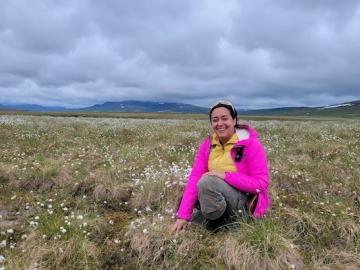
Filter News
Area of Research
- (-) Biology and Environment (52)
- (-) Materials (45)
- Advanced Manufacturing (3)
- Biology and Soft Matter (1)
- Building Technologies (2)
- Clean Energy (50)
- Computational Biology (1)
- Computer Science (1)
- Electricity and Smart Grid (1)
- Functional Materials for Energy (2)
- Fusion and Fission (16)
- Isotopes (4)
- Materials for Computing (6)
- National Security (28)
- Neutron Science (15)
- Renewable Energy (1)
- Supercomputing (39)
News Topics
- 3-D Printing/Advanced Manufacturing (5)
- Advanced Reactors (1)
- Artificial Intelligence (7)
- Big Data (1)
- Bioenergy (15)
- Biology (26)
- Biomedical (3)
- Biotechnology (3)
- Buildings (2)
- Chemical Sciences (14)
- Clean Water (3)
- Climate Change (16)
- Composites (4)
- Computer Science (5)
- Coronavirus (3)
- Critical Materials (4)
- Cybersecurity (2)
- Decarbonization (11)
- Energy Storage (15)
- Environment (26)
- Exascale Computing (2)
- Frontier (3)
- Fusion (1)
- Grid (4)
- High-Performance Computing (8)
- Hydropower (5)
- Isotopes (2)
- Machine Learning (5)
- Materials (26)
- Materials Science (10)
- Mercury (1)
- Microscopy (9)
- Nanotechnology (7)
- National Security (2)
- Net Zero (1)
- Neutron Science (5)
- Nuclear Energy (1)
- Partnerships (5)
- Physics (5)
- Polymers (4)
- Quantum Science (2)
- Security (1)
- Simulation (2)
- Summit (2)
- Sustainable Energy (11)
- Transformational Challenge Reactor (1)
- Transportation (3)
Media Contacts

ORNL researchers are deploying their broad expertise in climate data and modeling to create science-based mitigation strategies for cities stressed by climate change as part of two U.S. Department of Energy Urban Integrated Field Laboratory projects.

ORNL has provided hydropower operators with new data to better prepare for extreme weather events and shifts in seasonal energy demands caused by climate change.

Researchers at ORNL and the University of Tennessee, Knoxville, discovered a key material needed for fast-charging lithium-ion batteries. The commercially relevant approach opens a potential pathway to improve charging speeds for electric vehicles.

A new paper published in Nature Communications adds further evidence to the bradykinin storm theory of COVID-19’s viral pathogenesis — a theory that was posited two years ago by a team of researchers at the Department of Energy’s Oak Ridge National Laboratory.

When Hurricane Maria battered Puerto Rico in 2017, winds snapped trees and destroyed homes, while heavy rains transformed streets into rivers. But after the storm passed, the human toll continued to grow as residents struggled without electricity for months. Five years later, power outages remain long and frequent.

With wildfires increasing in scope and intensity around the world, Fernanda Santos’ research into how such calamities affect soil carbon storage has taken on new urgency.

Global carbon emissions from inland waters such as lakes, rivers, streams and ponds are being undercounted by about 13% and will likely continue to rise given climate events and land use changes, ORNL scientists found.

Researchers at ORNL explored radium’s chemistry to advance cancer treatments using ionizing radiation.

Researchers from ORNL, the University of Tennessee at Chattanooga and Tuskegee University used mathematics to predict which areas of the SARS-CoV-2 spike protein are most likely to mutate.

ORNL has been selected to lead an Energy Frontier Research Center, or EFRC, focused on polymer electrolytes for next-generation energy storage devices such as fuel cells and solid-state electric vehicle batteries.


